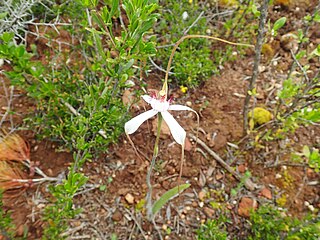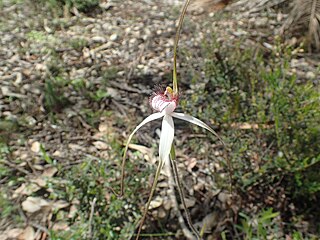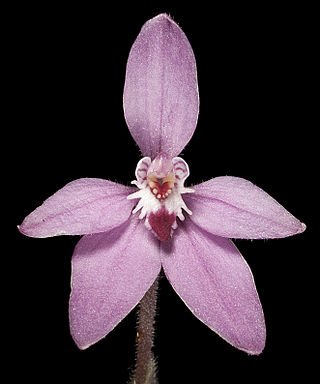
Caladenia hirta subsp. hirta, commonly known as the sugar candy orchid or candy orchid, is a plant in the orchid family Orchidaceae and is endemic to the south-west of Western Australia. It has a single leaf and up to three creamy-white or pink flowers with brownish tips and a brown back.
Caladenia longicauda subsp. albella, commonly known as the small-lipped white spider orchid, is a plant in the orchid family Orchidaceae and is endemic to the south-west of Western Australia. It has a single hairy leaf and up to four, mostly white flowers which have a pungent smell. It usually grows in seasonal swamps between Eneabba and Gingin.

Caladenia longicauda subsp. clivicola, commonly known as the Darling Scarp white spider orchid, or hills white spider orchid is a plant in the orchid family Orchidaceae and is endemic to the south-west of Western Australia. It has a single hairy leaf and up to three mostly white flowers with long, drooping lateral sepals and petals, a relatively small, narrow labellum and narrow labellum teeth. It grows in a restricted area, mostly on the Darling Scarp.

Caladenia longicauda subsp. crassa, commonly known as the Esperance white spider orchid, is a plant in the orchid family Orchidaceae and is endemic to the south-west of Western Australia. It has a single hairy leaf and up to three mostly white flowers with long, broad, spreading lateral sepals and petals, a relatively broad labellum with short, narrow teeth. It grows on the south coast between Bremer Bay and the Cape Arid National Park.

Caladenia longicauda subsp. eminens, commonly known as the stark white spider orchid, is a plant in the orchid family Orchidaceae and is endemic to the south-west of Western Australia. It has a single hairy leaf and up to three large, bright white flowers with long, broad, spreading lateral sepals and petals, a relatively broad labellum with short, narrow teeth. It is a relatively common orchid found in a broad band, mainly between Tenterden and Jerramungup.

Caladenia applanata subsp. applanata, commonly known as the broad-lipped spider orchid, is a species of orchid endemic to the south-west of Western Australia. It is a relatively common orchid with a single erect, hairy leaf and up to three flowers which may be red, cream, green or yellow and have a broad, flattened, red-tipped labellum.

Caladenia attingens subsp. attingens, commonly known as the forest mantis orchid or sneezing spider orchid, is a species of orchid endemic to the south-west of Western Australia. It is a relatively common orchid with a single erect, hairy leaf and one or two green, yellow and red flowers. It is similar to the fringed mantis orchid but has smaller flowers and has a more southerly distribution.

Caladenia attingens subsp. gracillima, commonly known as the small mantis orchid, is a species of orchid endemic to the south-west of Western Australia. It is a relatively common orchid with a single erect, hairy leaf and one or two green, yellow and red flowers. It differs from subspecies attingens in having smaller flowers and a more easterly distribution.

Caladenia longicauda subsp. merrittii, commonly known as Merritt's white spider orchid, is a plant in the orchid family Orchidaceae and is endemic to the south-west of Western Australia. It has a single hairy leaf and up to three large, mainly white flowers with very long, drooping lateral sepals and petals, and a white broad labellum with relatively short labellum teeth. It is one of the largest spider orchids.

Caladenia longicauda subsp. redacta, commonly known as the tangled white spider orchid, is a plant in the orchid family Orchidaceae and is endemic to the south-west of Western Australia. It has a single hairy leaf and up to three large, mainly white flowers with long, drooping lateral sepals and petals. It is most similar to subspecies eminems but has smaller flowers and shorter teeth on the side of the labellum.

Caladenia longicauda subsp. rigidula, commonly known as the rigid white spider orchid or island white spider orchid, is a plant in the orchid family Orchidaceae and is endemic to the south-west of Western Australia. It has a single hairy leaf and up to three large, mainly white flowers with relatively short lateral sepals and petals. It is similar to the reclining white spider orchid but that species has smaller, cream-coloured flowers.
Caladenia longicauda subsp. extrema, commonly known as the late white spider orchid or Seaton Ross spider orchid is a plant in the orchid family Orchidaceae and is endemic to the south-west of Western Australia. It has a single hairy leaf and one or two mainly white flowers with long, mostly spreading lateral sepals and petals. It is a relatively rare orchid which is similar to the tangled white spider orchid but has larger flowers and a later flowering period.
Caladenia longicauda subsp. minima, commonly known as the little white spider orchid, is a plant in the orchid family Orchidaceae and is endemic to the south-west of Western Australia. It has a single hairy leaf and up to three mainly white flowers with long, drooping lateral sepals and petals. It is a relatively rare orchid which is similar to the daddy-long-legs spider orchid but has smaller flowers and a more easterly distribution.

Caladenia pendens subsp. talbotii, commonly known as Talbot's spider orchid, is a plant in the orchid family Orchidaceae and is endemic to the south-west of Western Australia. It has a single hairy leaf and one or two white, red and yellow flowers with long drooping petals and sepals and sometimes has a citrus-like scent.
Caladenia pholcoidea subsp. pholcoidea, commonly known as the Albany spider orchid, is a plant in the orchid family Orchidaceae and is endemic to the south-west of Western Australia. It has a single hairy leaf and up to four pale yellow flowers with long drooping petals and lateral sepals.
Caladenia pholcoidea subsp. augustensis, commonly known as the Augustus spider orchid, is a plant in the orchid family Orchidaceae and is endemic to the south-west of Western Australia. It is a rare orchid with a single hairy leaf and up to three mostly white flowers with long spreading petals and lateral sepals.

Caladenia remota subsp. parva, commonly known as the Perenjori spider orchid, is a plant in the orchid family Orchidaceae and is endemic to the south-west of Western Australia. It has a single hairy leaf and up to three creamy-white to pale yellow flowers. It has a more restricted and more westerly distribution than subspecies remota.

Caladenia reptans subsp. reptans, commonly known as the little pink fairy or dwarf pink fairy, is a plant in the orchid family Orchidaceae and is endemic to the south-west of Western Australia. It has a single hairy leaf and up to three relatively small, pink flowers which have a labellum with three distinct lobes.
Caladenia reptans subsp. impensa, commonly known as the pale pink fairy, is a plant in the orchid family Orchidaceae and is endemic to the south-west of Western Australia. It has a single hairy leaf and up to three pale pink flowers which have a labellum with three distinct lobes. It is similar to subspecies reptans except that its leaf is green on both sides and the flowers are larger and on a taller flowering spike.

Caladenia uliginosa subsp. candicans, commonly known as the northern darting spider orchid, is a plant in the orchid family Orchidaceae and is endemic to the south-west of Western Australia. It has a single hairy leaf and up to three yellowish-cream flowers which have a forward-projecting labellum lacking the red tip of subspecies uliginosa.













